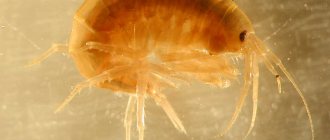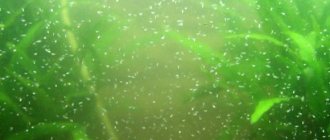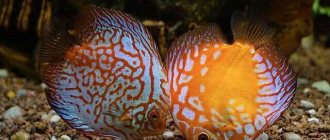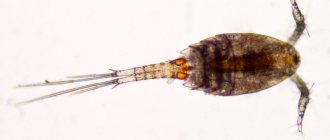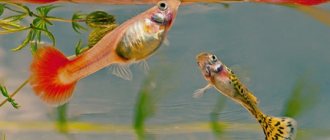Basic nutrition
The main nutritional ingredient of fish species depends on their natural type:
- carnivores;
- herbivores;
- omnivores.
Depending on it, the basis of nutrition consists of meat, insects, plants, and vegetables. And then you should add additional supplements in the form of vitamins and microelements.
Food in an aquarium should be at least approximately similar to food in nature. For long-domesticated fish in the form of guppies and goldfish, this is not so important. But for recently domesticated or wild fish that were caught as fry, a sudden change in the basis of nutrition will cause health problems. After all, fish from central Russia cannot be fed with tropical insects and their larvae, because this is food unusual for them.
Squirrels
Proteins are responsible for the nutritional value of food, form the muscle mass and bones of fish, and release energy when there is a lack of carbohydrates. For carnivores, 60% of the diet should consist of protein foods. But dry food in the form of flakes, granules, tablets usually contain 40–45% proteins, so feeding with live food is mandatory.
But not just any type of protein is suitable for predatory fish. After all, food contains animal protein and vegetable protein. For carnivores, excessive amounts of plant protein cause digestive problems. And the body of herbivorous fish does not accept much animal protein.
Sources of animal protein:
- All types of fish.
- Molluscs and crustaceans.
- Bird eggs.
The meat of birds and most mammals is not suitable for fish. But it is allowed to add calf liver and beef heart to homemade feed.
Vegetable protein sources:
- Cereals.
- Legume family.
- Spirulina.
- Chlorella.
Fats
Another important nutritional component that provides a large amount of energy. It is easy to make a mistake with fats in the diet, this will lead to overeating and obesity in pets. Therefore, the fat content in the feed should not exceed 5–10%. With excess fat, fish lose their ability to reproduce and have digestive problems.
Sources of fats:
- Fatty fish species (usually marine species).
- Bird eggs.
- Fish fat.
- Crustaceans.
- Shellfish.
- Vegetable fat (rapeseed, soybean oils).
The fat of birds and mammals is poorly absorbed by the fish body. You can recognize low-quality food by its ingredients: “pork fat”, “beef fat”. Palm oil is also poorly absorbed.
Carbohydrates
Organic carbohydrates are a source of rapidly renewable energy. But when they are in excess, they are easily deposited in adipose tissue, leading to obesity in the inhabitants. Only “noble” carbohydrates, which are found in vegetables, fruits, cereals, bran, grains, and herbs, are beneficial for the health of fish. The rest of the carbohydrates cause only a rapid increase in energy, and then its sharp decline. Such carbohydrates are found in flour, sugar, and bread.
Historical facts
The first mentions of artificial reservoirs with inhabitants of the water element date back to Ancient Egypt. The paintings of some ancient temples contain images of fish kept in home ponds.
The most common fish among the Egyptians was the African tilapia fish. In addition to it, in ancient drawings you can see catfish, elephant fish, mormirus, and chromis.
The Egyptian tradition was continued by the famous ruler of Babylon, Nebuchadnezzar, who decorated the gardens of his beloved wife Amytis with ponds and pools with fish.
They kept fish in Ancient Rome, but this type of activity gained particular popularity in China and Korea, and then in Japan. It was in the East that they learned to create amazingly beautiful goldfish.
By the 15th century, about forty species of unusual fish had been bred. About a century later, rumors about strange creatures reached Europe, and later the fish themselves appeared in the ponds of the royals of the old world.
Vitamins
Natural and synthetic vitamins are used in feed. Natural ones are quickly absorbed, but if they are deficient, synthetic ones also provide benefits.
Key vitamins in feed:
| Vitamin | What does it contain? | Benefit |
| WITH | Spinach, parsley, nettle | Supports the immune system, helps synthesize collagen, strengthens blood vessels |
| A | Fish meat, carrots, red pepper, eggs | Supports vision, nourishes skin, improves fish coloration |
| E | Parsley, pepper, spinach leaves | Antioxidant, improves blood flow, supports the immune system. Has a beneficial effect on the reproduction process |
| TO | Cabbage, parsley, lettuce, dandelions | Responsible for blood clotting |
| IN 1 | Legumes, yeast, grains, spinach | Increases appetite, strengthens muscles, is responsible for the brightness of color |
| AT 2 | Shellfish, fish meat, bird eggs, yeast | Accelerates metabolism, supports vision, nourishes the skin and mucous membranes. Supports the Immune System |
What food is best to feed
The choice of food for aquarium fish depends on:
- on the characteristics of the organism: predators, herbivores or omnivores;
- whether they catch food on the surface, in the water column or at the bottom.
The appearance, color and size of food particles are also important. Food with large granules is not suitable for pets with small mouths. And some are more willing to eat colorful particles that resemble insects.
| Difference between fish | Nutrition | Diet |
| Viviparous | Omnivores, eat meat and plant foods well. Typically, the basis of the diet is dry food in the form of flakes, granules, and chips. And they supplement the diet with vegetables, fruits, berries, herbs and protein products. | Worms, insects and their larvae, meat products, herbs, vegetables, fruits, algae and more. |
| Predatory | In the natural environment, live food became the food of predators. Therefore, high-protein food is required in the aquarium. Live prey excites the appetite of predators, but dead meat is also suitable. | Live small fish, livestock meat. Insects, larvae, earthworms are suitable. |
| Bottom | Bottom-dwelling fish collect food from the substrate, at the bottom of the aquarium walls. Therefore, they require heavy particles that quickly sink to the bottom. This is especially important if there are other inhabitants in the aquarium who eat the food before it sinks to the bottom. | Dry tablets for bottom fish, coretra, tubifex, bloodworms, cucumbers, lettuce and dandelion leaves. |
| Fry | Their future health and size depend on the fry’s nutrition. After all, it is from the initial feeding that the fry gain strength and energy to explore the world. Therefore, high-protein live food is desirable. | Crushed earthworms, live dust, nematodes, small egg yolks, ciliates. |
Selection rules
When choosing dry food for your fish, you should be guided by one rule - to help, and not harm, the inhabitants of the aquarium. Poor quality granules quickly disintegrate in water and pollute the water.
When purchasing, you need to pay attention to the following points:
- Shape and material of packaging;
- Shelf life;
- Product storage location.
Vitamins A and D 3 are light sensitive and the wrapper should protect the contents as best as possible. Food in plastic bags, as well as those sold by weight, do not meet basic sanitary standards and therefore it is better to refuse to purchase them.
The shelf life of the product is no less important. Very often, there are products on store shelves that are approaching their expiration date. Such food can be harmful to aquarium fish.
If food is stored on a store display for a long time, a number of useful microelements may disappear from it. Products stored in a damp room are at even greater risk - the risk of fungi and mold forming inside the packaging is very high.
Types of feed
All types of fish feed are divided according to preparation technique and composition.
Among them are:
- Live food is food made from live insect larvae and worms.
- Frozen - Almost all types of live food can be frozen.
- Dry - consists of dried and crushed ingredients in the form of flakes, granules or tablets.
- Vegetable - cereals, vegetables, fruits, berries, herbs that are healthy for fish.
Alive
Live food is considered the most nutritious due to its high amount of protein. It pollutes the aquarium less than dry food. Due to its nutritional value, live food is recommended to be fed to fry and fish during the breeding season. But the danger of such food is the possibility of infection of fish if there is an infection in the larvae and worms.
How to disinfect live food:
- Crush a few cloves of garlic and put it in the water with the larvae or worms. After an hour, remove the garlic.
- Keep live food for several hours in a light pink solution of potassium permanganate.
- Immerse the larvae in a 5% salt solution for 10 minutes 2 times a week.
- Ichthyophore preparation. Add 50 drops to 100 ml, soak the larvae for 30 minutes.
- 5% piperazine solution, immerse larvae and worms for 15 minutes.
- Dissolve 2 metronidazole tablets in 10 liters of water.
- Dilute 250 mg of erycycline in 1 liter of water. Soak the larvae for an hour.
- Dilute 0.1 g of trypaflavin in 10 liters of water. Place the larvae in the solution for 2 days.
- Dilute 100 mg of kanamycin in a liter of water. Soak live food for an hour.
Common types of live food:
| View | Description | Choice | Feeding | Storage |
| Bloodworm | Larvae of blood-sucking mosquitoes with a protein content of 60%. Bright red color. | When choosing, pay attention to the bright red color of the larvae and their mobility. | After storage in the refrigerator, you can feed the fish. They are given in small portions. Suitable for carnivorous and omnivorous fish. | During storage, dead and immobile larvae are removed. Before storage, rinse several times in running water and disinfect. Keep in the refrigerator for 3 days. |
| Koretra | Larvae of non-blood-sucking mosquitoes. Externally they look like translucent pale yellow small larvae. Protein content 40%. | Choose actively moving larvae without a cloudy coating or strong odor. | It is advised not to feed pure coretra, but to combine it with other food. Feed 2 times a week. | Rinse in running water, get rid of motionless larvae, then place in the refrigerator for 3 days. |
| Tubifex | It belongs to the annelids, grows up to 4 cm. It has the largest amount of protein, which means it is highly nutritious. | Choose live and moving red worms. | Feeding tubifex usually requires floating feeders in which the worms are placed. In small quantities they are simply dropped into the aquarium. | Be sure to disinfect them, infections are common in them. After purchasing, store in the refrigerator for a week without giving it to the fish. Wash the worms twice a day and remove the dead ones. |
| Daphnia | Crustaceans living in freshwater bodies. Contains 50% protein. Usually, due to its size and nutritional value, it is used as the first complementary food for fry. | When purchasing a mass of daphnia, there should be a large portion of active and moving crustaceans. | Feed in small portions. Suitable only for small fish and fry; large ones can simply not notice the crustaceans. | Store in the refrigerator in water. Carry out disinfection. |
| Earthworms | Worms that live everywhere. You can collect and breed them yourself, just dig them up and place them in a tank with soil, sand, or turf. After a while, the worms give birth to offspring, which are fed to the fish. | Choose active worms. | Suitable for large fish, small ones simply will not swallow them. But if you chop it thoroughly, you can feed them even to grown fry. | Store in containers with soil. They cannot be fed directly from the ground to fish; before this, they are kept for 2 days without food and soaked in water to cleanse the insides from the soil. |
Dry
Dry food is easy to store because it has a long shelf life, unlike live food. Also, dry food is often divided by type. Such feeds take into account the characteristics of fish and satisfy their individual needs. But their nutritional value is much lower than that of live food, and even with constant feeding they require additional vitamin supplements.
| Kinds | Description | Choice | Feeding | Storage |
| Pills | Round and heavy tablets are ideal for feeding bottom-dwelling fish. The tablet quickly falls to the bottom and begins to get wet. | The tablets in the package must be solid, not crumbly, and hard. | Give 1–3 tablets at a time, depending on the number of bottom fish. | Store in a dry place, avoiding high humidity. |
| Cereals/chips | Flakes and chips are fragile and break easily, so they are eaten by fish of all sizes. They sink slowly to the bottom, so they are suitable for the upper and middle inhabitants of the aquarium. Low nutritional value. The composition is similar to granules. | Although cereals and chips are fragile in structure, they must be intact in the package. | Feed in small portions, all flakes must be eaten within 5 minutes, otherwise they will quickly pollute the aquarium and water. | Store in a dry place. |
| Granules/sticks | They are divided as food for swimming and bottom fish: there are floating granules or quickly sinking ones. They increase in volume in water, take this into account when dosing granules. | When packaged, they should be dense and difficult to break apart with your fingers. | Give a few sticks or granules and wait until they swell. | Store in a dry place. |
| Microfeed | It looks like a mixture of proteins and cereals turned into dust or dust. They feed fry and young small fish. | Microfeed should not be sticky - this is a consequence of high humidity and possible moldiness. | It quickly pollutes the aquarium, so give it in small portions. The fry should eat the microfeed within a couple of minutes. | Store in a dry place. |
High-quality dry food is determined by its composition components.
Healthy Ingredients:
- Spirulina. Algae rich in amino acids, fatty acids, minerals, vitamins, beta-carotene.
- Shrimp meal. Particularly suitable for brightly colored fish to maintain color. Contains useful substances and is highly nutritious.
- Fish flour. Consists of crushed and dried fish. Contains fatty acids, amino acids and vitamins. Fish meal in the composition helps to eat less food.
- Squid meal. It is created from the remains of squid that are not used for production. But they are highly nutritious and contain vitamins and microelements. They stimulate the appetite of fish that are malnourished.
- Mealworms. Increases the nutritional value of dry food due to its high protein and fat content. Also contain vitamin D.
The most popular manufacturers of types of fish food (in Moscow):
- ADA (Japan).
- Biodesign (Russia).
- Dennerle (Germany).
- PRODAC (Italy).
- Sera (Germany).
- Tetra (Germany).
- Zoomir (Russia).
- Wardley (USA).
Frozen
| View | Description | Choice | Feeding | Storage |
| Frozen food | Almost all types of live food are frozen and sold in small portions in rectangular briquettes. | Briquettes should not be completely defrosted, with traces of damage to the shell or mold. | Break off a small piece from the briquette and defrost it under running water. If you defrost too much, put it in the refrigerator. It cannot be re-frozen, as this will lose most of the nutrients. | Store frozen in the refrigerator. |
Vegetable
| View | Description | Choice | Feeding | Storage |
| Semolina | Contains substances and fiber that are beneficial to the body. | Any semolina sold in stores is suitable. | 1 tbsp. l. Pour boiling water over the cereal and let it swell for 15 minutes. Give in small portions. | Store in the refrigerator for no more than 2 days. |
| Carrots, lettuce and broccoli | Vegetables and greens are high in vitamins. | Choose fresh and juicy vegetables and herbs. | Before feeding, vegetables and herbs are doused with boiling water or boiled so as not to introduce infection into the aquarium. Then they are finely chopped and given in small portions. | Store in the refrigerator for a couple of days. |
| Cereals | They improve the functioning of the digestive system and enrich the body with microelements. | Any cereal from stores. | Grind in a blender, coffee grinder or meat grinder. Pour boiling water over it. Rinse the resulting porridge under running water. Give the remaining swollen flakes in a small portion to the aquarium. | Store leftovers in the refrigerator. |
Auxiliary compounds
Auxiliary compositions are necessary for fish that require increased feeding due to illness, the breeding season, or simply high activity during the day (cichlids, barbs). Also, additional formulations are suitable for fish that do not have time to eat enough with everyone during the feeding period.
Auxiliary formulations are usually made from high-protein foods: larvae, krill, crustaceans with jelly and fatty acids. Available in tablet form. But such nutrition is not typical for fry, so it is better to continue keeping them on live food.
Top brands
Among the best manufacturers of food for aquarium fish, experts note the following:
- German Tetra.
- Japanese "Hikari".
- Polish "Tropical".
The German brand offers high-quality food for all breeds of aquarium fish in the form of balls, tablets, sticks, etc.
The Japanese company produces both floating and sinking premium food. Dry food contains proteins, grains, fats, and vitamin complexes.
The Poles produce more than two hundred feeds containing vitamins. The line of cheap but high-quality food includes universal, medicinal, and special products.
Harmful Ingredients
Many cheap aquarium foods contain ingredients that are neutral to health but also not beneficial. So feeding such food will weaken the fish’s body over time, because along with food it does not receive all the necessary substances for immunity. Ingredients that are actually harmful to the health of the inhabitants are less common.
List of products that should not be included in fish food:
- Wheat flour. Even for the human body, it is not recognized as particularly useful, but for fish who are not accustomed to such a product, flour can be harmful to the digestion of fish. It does not contain useful substances, it only greatly increases the level of glucose in the body. And this provokes fish obesity. Wheat flour is especially harmful to fish in small aquariums, where they are not able to expend extra energy.
- Potato protein. It also contains an excess of easily broken down carbohydrates, which are converted into glucose. If you constantly feed the inhabitants food with potato protein, this will lead to obesity and decreased activity, and then to diseases of the internal organs.
- Soy flour. Soy is not so harmful to the body, but it also contains a large amount of carbohydrates and has little benefit for the body.
- Wheat gluten. These are almost empty carbohydrates that are quickly absorbed. With a lack of movement, they are stored as fat. Used as a binding element for other ingredients.
Every aquarist knows that you should not give fish food from your table, because it is usually over-salted, contains sugar, seasonings and other harmful additives.
Homemade food for aquarium fish
Most often, homemade food is fed to their pets by experienced aquarists who want to achieve completely healthy food with all the necessary vitamins and microelements. After all, even the most highly rated and complete food, with constant feeding, can cause a deficiency of some substances in the body.
The basis of homemade fish food for omnivorous underwater inhabitants will be:
- Meat and by-products of fish and cattle.
- Vegetation.
- Fruits, vegetables, berries.
- Cereals.
- Microorganisms and protozoa.
- Crustaceans, molluscs.
- Insects and their larvae.
- Worms.
The simplest fish food recipe is to cook them scrambled eggs/omelettes. This does not mean that it is allowed to feed leftover food from the human table to pets; food for fish is prepared separately.
- Break 1 egg and pour into boiling water, wait for complete coagulation (1 minute).
- Remove the resulting omelette with a colander or spoon and finely chop.
- Give the fish in small portions; all particles must be eaten.
Recipes with lots of ingredients:
| Ingredients | Cooking process |
|
|
|
|
|
|
|
|
How to make it at home with your own hands
Homemade homemade food can be both plant-based and for predatory fish.
The material in the first case is fruits, boiled vegetables, plant leaves, in the second - pieces of fish or seafood. The ingredients are crushed using a blender or meat grinder, placed on a tray and frozen. After a few hours, take it out, break it into pieces and put it in bags.
To prepare dry food, the crushed mass is spread in a thin layer on any surface with foil and dried, then crumbled and placed in jars. You can add different products - eggs, offal, paprika, etc.
Step-by-step instructions for making your own omelet:
- Beat the egg into boiling water and wait for it to coagulate for a minute.
- Remove the mass and grind.
- Place small portions in the aquarium.
Adviсe
- Avoid overfeeding pets. Obesity negatively affects the entire body of underwater inhabitants, reducing their life expectancy by half. Overfeeding leads to water contamination with ammonia toxins. It is better to underfeed than to overfeed.
- Feed strictly according to a certain dosage. The fish should eat all the food in the tank within 3-5 minutes. If more than 7–10 minutes have passed, then the next dose of food is reduced.
- Fasting days and short fasts are necessary to keep the fish's body in good shape. This eliminates the consequences of previous overfeeding, increases the desire to reproduce, and cleanses the body.
- Food for aquarium fish should be varied - live organisms, herbs, vegetables and fruits are added to it.
- Feed several times a day. If you give fish food once a day, this will adversely affect the body of even adult fish, not to mention young and elderly fish. Adult inhabitants are fed 2 times a day, fry 5–6 times, and adolescents 3–4 times a day.
- Consider your pet's nutritional needs. It is recommended to increase the dosage of feed before and during spawning, after illness. When the water temperature drops, metabolism slows down, so the amount of food decreases.
- Each species has its own feeding habits. If you keep more than one species in one aquarium, then take care to satisfy each of them with different foods. Some companies make foods for all species, but they are usually less healthy than foods for individual species. In this case, at least purchase 2 types of fish food: for carnivores and herbivores.
Selecting food for underwater pets is an important part of keeping and care. Here you need to focus on the type of food, oral apparatus, activity, habitat. What kind of food do you prefer to give to aquarium fish?
Previous
FishAll known aquarium cleaners
Next
FishPeaceful and shy pelvicachromis pulchera
Where to buy and how much it costs
There will be no problems with the purchase - in any locality there are specialized stores for animals. You just have to avoid buying in dubious places such as markets or street trading - no one will give you a guarantee of quality, which is especially important when purchasing live food.
Cheap products are not the best choice. As a rule, you have to save on production technology, which also affects quality. The least trouble is severe contamination of the water in the tank.
A very simple and convenient way is to order online in an online store. In this case, you can get acquainted with the description and characteristics of the product, read reviews from aquarists and listen to their advice. If you purchase a large weight, the goods will be delivered to your apartment door. All new items that appear on sale are also available for order.

